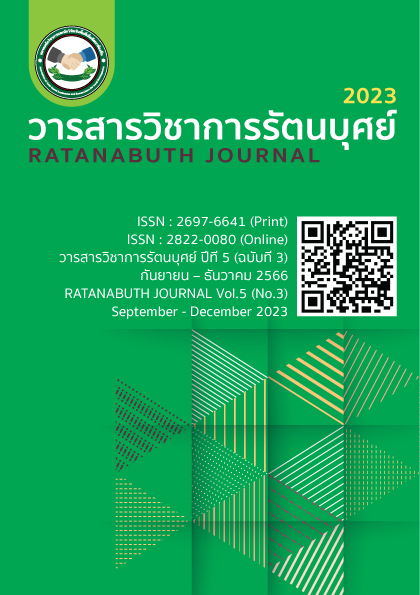การปฏิวัติประสิทธิภาพ: ผลกระทบขององค์กรเสมือนจริงต่อการเปลี่ยนแปลงพลศาสตร์การจัดการ Revolutionizing Efficiency: The Impact of Virtual Organizations on Transforming Management Dynamics
Main Article Content
บทคัดย่อ
แนวคิดเกี่ยวกับองค์กรเสมือนจริงถือกำเนิดขึ้นในทศวรรษ 1990 เพื่อเป็นโซลูชันในการจัดการกับความท้าทายและใช้ประโยชน์จากเทคโนโลยีสารสนเทศ บทความนี้กล่าวถึงการปฏิวัติประสิทธิภาพและผลกระทบขององค์กรเสมือนจริงในการเปลี่ยนแปลงพลวัตการจัดการ องค์กรจำเป็นต้องปรับตัวและวางแผนสำหรับอนาคตเพื่อตอบสนองต่อการเปลี่ยนแปลงอย่างรวดเร็วของภูมิทัศน์ทางเทคโนโลยี ในอดีต องค์กรต่างๆ อาศัยกลยุทธ์ต่างๆ เช่น การผูกขาดเพื่อความอยู่รอด แต่ในยุคของเทคโนโลยีสารสนเทศ จะต้องรวดเร็วและตอบสนองความต้องการของลูกค้า องค์กรเสมือนจริงถูกสร้างขึ้นโดยความร่วมมือของหลายองค์กร โดยใช้ประโยชน์จากเทคโนโลยีสารสนเทศเพื่อการสื่อสารที่มีประสิทธิภาพและความสะดวกสบาย องค์กรเหล่านี้ต้องการความยืดหยุ่น การตอบสนอง และความคุ้มทุนเพื่อการเติบโตในสภาพแวดล้อมทางธุรกิจในปัจจุบัน
Article Details

อนุญาตภายใต้เงื่อนไข Creative Commons Attribution-NonCommercial-NoDerivatives 4.0 International License.
เอกสารอ้างอิง
เทพศักดิ์ บุณยรัตพันธุ์. (2553). องค์การเสมือนจริง (Virtual Organization). ออนไลน์. แหล่งที่มา : http://www.drmanage.com/index.php?lay=show&ac=article&Id=538632228
เรวัต แสงสุริยงค์. (2547). การบริการอิเล็กทรอนิกส์: ตัวแบบสำหรับการให้บริการสาธารณะของ ไทย.วิทยานิพนธ์หลักสูตรปริญญารัฐศาสตรดุษฏีบัณฑิต สาขาวิชารัฐศาสตร์, คณะรัฐศาสตร์:กรุงเทพฯ: จุฬาลงกรณ์มหาวิทยาลัย
รัตนาภรณ์ แววกระโทก. (2555). องค์การเสมือนจริง (Virtual Organization).สืบค้นเมื่อ 23 กันยายน 2566 จาก https://www.gotoknow.org/posts/451681.
Allen, T. D., Golden, T. D., & Shockley, K. M. (2015). How Effective Is Telecommuting? Assessing the Status of Our Scientific Findings. Psychological Science in the Public Interest, 16(2), 40–68. doi:10.1177/1529100615593273.
Anderson, R., & Moore, T. (2006). The Economics of Information Security. Science, 314(5799), 610–613. doi:10.1126/science.1130995.
Brynjolfsson, E., & McAfee, A. (2014). The Second Machine Age: Work, Progress, and Prosperity in a Time of Brilliant Technologies. W. W. Norton & Company.
Cabrera, A., Collins, W. C., & Salgado, J. F. (2006). Determinants of Individual Engagement in Knowledge Sharing. The International Journal of Human Resource Management, 17(2), 245–264. doi:10.1080/09585190500386642.
Carmeli, A., Gilat, G., & Waldman, D. A. (2007). The Role of Perceived Organizational Performance in Organizational Identification, Adjustment and Job Performance. Journal of Management Studies, 44(6), 972–992. doi:10.1111/j.1467-6486.2007.00723.x.
Choi, J. H., & Varian, H. (2012). Predicting the Present with Google Trends. Economic Record, 88(s1), 2–9. doi:10.1111/j.1475-4932.2012.00809.x
Daft, R. L., & Lengel, R. H. (1986). Organizational Information Requirements, Media Richness and Structural Design. Management Science, 32(5), 554–571. doi:10.1287/mnsc.32.5.554.
Davenport, T. H., & Ronanki, R. (2018). Artificial Intelligence for the Real World. Harvard Business Review, 96(1), 108–116.
Demirel, D. (2017). The instrumental use of information technology: the increasing importance of virtual organizations. International Conference on Science and Education, 8(8),93-102.
Dhillon, G., & Backhouse, J. (2001). Information System Security Management in the New Millennium. Communications of the ACM, 44(7), 125–128. doi:10.1145/379300.379332.
Etzioni, O., Etzioni, O., Etzioni, O., Etzioni, O., Etzioni, O., Etzioni, O., & Etzioni, O. (2017). AI for the Common Good: A Framework for Ethical AI. Communications of the ACM, 60(1), 34–37. doi:10.1145/2977602.2977611.
Fomenko, E.V., Luneva, T., & Nikitin, E.V. (2021). Role and functions of virtual organizations in context of COVID-19 pandemic. 2021(3):37-43. doi: 10.24143/2073-5537-2021-3-37-43.
Gibson, C. B., & Cohen, S. G. (2003). Virtual Teams that Work: Creating Conditions for Virtual Team Effectiveness. San Francisco: Jossey-Bass.
Hinds, P. J., & Mortensen, M. (2005). Understanding Conflict in Geographically Distributed Teams: The Moderating Effects of Shared Identity, Shared Context, and Spontaneous Communication. Organization Science, 16(3), 290–307. doi:10.1287/orsc.1050.0139.
Jackson, S. E., & Ruderman, M. (1999). Diversity in Work Teams: Research Paradigms for a Changing Workplace. American Psychologist, 54(4), 17–63. doi:10.1037/0003-066x.54.4.17.
Joslin, R., & Müller, R. (2015). Relationships between a Project Management Methodology and Project Success in Different Project Governance Contexts. International Journal of Project Management, 33(6), 1377–1392. doi:10.1016/j.ijproman.2015.02.002.
Kaur, R., & Chhikara, N. (2020). Applications of Virtual Reality and Augmented Reality in Enterprises. In R. Rautaray & A. Agrawal (Eds.), Emerging Technologies in Data Mining and Information Security,113–132) Springer. doi:10.1007/978-981-15-4990-3_7.
Leonardi, P. M., Huysman, M., & Steinfield, C. (2013). Enterprise Social Media: Definition, History, and Prospects for the Study of Social Technologies in Organizations. Journal of Computer-Mediated Communication, 19(1), 1–19. doi:10.1111/jcc4.12029.
Matsumoto, D. (2017). The Handbook of Culture and Psychology. Oxford University Press.
Milgram, P., & Kishino, F. (1994). A Taxonomy of Mixed Reality Visual Displays. IEICE Transactions on Information and Systems, E77-D(12), 1321–1329.
Mowshowitz, A. (2002). Virtual Organization. In Encyclopedia of Information Systems, (4),53–66. Elsevier.
Nah, F. F. H., & Lau, J. L. S. (2001). Critical Factors for Successful Implementation of Enterprise Systems. Business Process Management Journal, 7(3), 285–296. doi:10.1108/14637150110392773.
Powell, A., Piccoli, G., & Ives, B. (2004). Virtual Teams: A Review of Current Literature and Directions for Future Research. ACM SIGMIS Database, 35(1), 6–36. doi:10.1145/974491.974495.
Prema, J., & Loyd, B.L. (2015). Virtual Organization of Grid – Pipeline Virtual
Organization (PVO) Approach. International Journal of Computer Applications Technology and Research, 4(4):312-317. doi: 10.7753/IJCATR0404.1019.
Rasmussen, T., Ulrich, D., & Kaufman, S. (2011). Learning from Practice: How HR Connects the Dots between People and Performance. Organizational Dynamics, 40(4), 236–244. doi:10.1016/j.orgdyn.2011.06.005.
Rezazadeh, H., & Molaei, H. (2018). The relationship between the degree of organization's virtualization and the organizational ability. Management Science Letters, 8(6):619-630. doi: 10.5267/J.MSL.2018.4.029.
Schwalbe, K. (2018). Information Technology Project Management. Cengage Learning.
Stefan, H., & Fayzullin, R. (2020). The organizational concept of the virtual corporation and its integration into Industry, 4 5(3):132-137.
Swan, M. (2015). Blockchain: Blueprint for a New Economy. O'Reilly Media.
Tapscott, D., & Tapscott, A. (2016). Blockchain Revolution: How the Technology Behind Bitcoin and Other Cryptocurrencies is Changing the World. Penguin.


